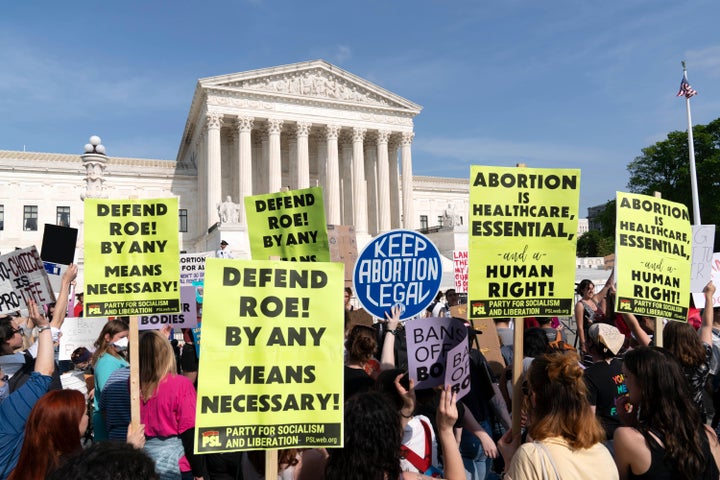With the Supreme Court poised to roll the clock back half a century on abortion, codifying Roe v. Wade just became alarmingly urgent for those who believe a person has the right to terminate their pregnancy.
The landmark Roe decision legalized abortion on a national scale when it was handed down in 1973, but there’s ample reason to believe we won’t be celebrating its 50th anniversary. The Supreme Court confirmed on Tuesday that a draft of a decision on a pending abortion rights case published by Politico on Monday was indeed authentic.
The draft takes a hard-line stance, criticizing abortion in part on the basis that it is “not deeply rooted in the Nation’s history and traditions.” It strikes a very different tone from the one the court took in 1992 when the majority opinion in Planned Parenthood v. Casey emphasized how the “ability of women to participate equally in the economic and social life of the Nation has been facilitated by their ability to control their reproductive lives.”
Americans do not need to rely on the Supreme Court to ensure abortion care is legal: Elected representatives, backed by a majority of Americans who support Roe, could enact a law cementing the right to an abortion.
But it does not appear very likely to happen nationwide. Here’s why.
Congress could pass the Women’s Health Protection Act.
Senate Majority Leader Chuck Schumer announced Tuesday his chamber would vote on the Women’s Health Protection Act, a bill the House passed back in September that would codify the right to an abortion. President Joe Biden has already said he “strongly supports” the bill, so would no doubt sign it.
The measure would legalize abortion before fetal viability and in cases where the health of the mother is at risk. It specifically calls out a long list of speed bumps implemented by conservatives in some states ― things like mandatory wait times ― and bans them.
But it faces seemingly unsurmountable hurdles in the Senate.
While the Democrats control the Senate, the chamber is split 50-50 with Republicans. (Vice President Kamala Harris casts the deciding vote, if needed.) So Democrats would first need everyone on their side to get on board with the Women’s Health Protection Act, which is not the case right now since Sen. Joe Manchin (D-W.Va.) opposes abortion rights.
Then, even if the Democrats could present a united front, they would need to overcome the filibuster, which is the Senate rule that says at least 60 members must agree to bring a bill to the floor for a vote, where it could then pass with a simple majority. The Democrats don’t have 60 votes ― they’d need to convince Manchin plus 10 Republicans.
That means Schumer’s call for a vote is mostly symbolic: It will force each senator to commit to the record their stance on abortion rights. And there’s little reason to believe anything has changed since March when the Senate tried to pass the bill but was blocked by every Senate Republican, plus Joe Manchin.
If passed, the Women’s Health Protection Act will likely face legal challenges, Linda McClain, a law professor at Boston University who addresses gender-based inequality, told HuffPost.
But officials could also make the argument that “access to abortion is vital to the equal protection of women,” McClain theorized, or that it affects interstate commerce, which Congress can regulate. (Some women who live in states where abortion is restricted already choose to travel to other states, although many do not have the resources to do so.)

The Senate could eliminate the filibuster.
Eliminating the filibuster would mean the Women’s Health Protection Act could pass with a simple majority, without the 60-vote threshold.
But to get rid of the rule, you need a united Democratic front, and there are currently two senators who flat-out refuse to trash the filibuster: Manchin and Sen. Kyrsten Sinema (D-Ariz.).
Both reaffirmed their stance on the issue in the wake of Politico’s surprise report. And even if they did change their minds on the filibuster, Manchin remains an opponent to abortion, leaving Democrats one vote short.
Individual states could enact abortion protections.
Sixteen states and the District of Columbia have already enacted legislation to protect abortion rights, according to the Guttmacher Institute.
If the Supreme Court does indeed overturn Roe v. Wade, women could still lawfully terminate a pregnancy in Connecticut, California, Colorado, Delaware, Hawaii, Illinois, Maine, Maryland, Massachusetts, Nevada, New Jersey, New York, Oregon, Rhode Island, Vermont and Washington state.
But many others have gone in the opposite direction. By Guttmacher’s count, 22 states have laws or amendments to their state constitutions that would ban abortion as soon as the Supreme Court overturns Roe v. Wade. That group includes Arizona, Georgia, Michigan, Ohio and Texas, among others.Some legal experts believe Minnesota would protect abortion access, but the Guttmacher Institute said it wouldn’t “necessarily” do so since the state doesn’t currently have such laws in place.
Another four states ― Florida, Indiana, Montana and Nebraska ― would be likely to ban abortion in such a scenario, according to Guttmacher.
Challenges to these states’ anti-abortion laws could work their way up to the Supreme Court, but since the court appears poised to overturn Roe, the laws would probably be permitted to stand.
The Supreme Court’s decisions in Roe and Casey created an “undue burden” standard to determine whether an abortion law is constitutional, which meant that abortion is legal and states cannot place substantial obstacles in the path of the person seeking an abortion. (Things like mandatory wait times and ultrasounds are not considered undue burdens.)
In the draft opinion, however, Supreme Court Justice Samuel Alito outlined a new way to test whether an abortion law is constitutional, using the “rational basis” test. It’s a low level of scrutiny normally used “for ordinary social and economic legislation,” McClain told HuffPost.
“So what this means is all the states out there that either have these restrictive abortion laws from [pre-]Roe days that they weren’t allowed to enforce anymore or have new ones ready to roll out, the court’s signaling that those are not going to be subject to constitutional review except at a very, very relaxed level,” McClain said. “And that relaxed level means that if you can come up with some legitimate reason for this law ... we’re not going to mess with what the democratically elected representatives of your state have to say about this issue.”
Congress could add seats to the Supreme Court.
Nowhere does the Constitution say there need to be nine Supreme Court justices. In fact, the number of justices has fluctuated over the course of American history, although it’s been pretty stable for the past 150 years.
A year ago, several Democratic lawmakers introduced a bill to expand, or “pack,” the court: Reps. Jerrold Nadler (D-N.Y.), Hank Johnson (D-Ga.) and Mondaire Jones (D-N.Y.) in the House and Sen. Ed Markey (D-Mass.) in the Senate wanted to add four new judges.
House Speaker Nancy Pelosi (D-Calif.) quickly shot it down, saying she had no plans to bring the bill to the floor for a vote in the House, but it’s possible that the Supreme Court’s draft opinion could spur Democrats in Congress to reevaluate the idea.
The court’s current lineup consists of six judges considered conservative and three considered liberal, although Chief Justice John Roberts occasionally abandons his fellow right-wingers. Former President Donald Trump famously got to pick three of the current justices. If Biden could add four liberals, that’d shift the balance back in favor of Democratic policy.
Expanding the court could be useful even if Democrats managed to pass the Women’s Health Protection Act, as legal challenges to the measure could eventually work their way up to the Supreme Court ― a Supreme Court that, again, is currently signaling it has no interest in protecting abortion rights.
Voters could shake up the House and Senate this fall.
Democrats’ control of Congress is at stake in the 2022 midterms, an election in which the president’s party historically does not do well. Nothing is set in stone, though, and a large Democratic turnout could theoretically give the party more control of the House and Senate.
The leak of the Supreme Court’s draft opinion could potentially help.
“It was extremely disheartening how little attention the court gave to the way in which abortion access has been critical to women’s reproductive health, and their ability to, you know, participate in the life of the nation,” McClain said of Alito’s draft.
“By contrast to Roe and Casey, there is almost no attention to what it means to be pregnant. There’s no attention to the physical burdens of pregnancy,” she added.
Mini Timmaraju, president of NARAL Pro-Choice America, told reporters Tuesday that “this is the moment, the wake up call, for not just our base voters but our allies across the spectrum.”
“The reproductive rights and justice movements have been telling everyone for decades ... this was coming,” Timmaraju said. “That Roe was already ineffective in large parts of the country, already ineffective for women of color, people of color.”
But she acknowledged the challenge: “It’s been really hard to organize around it, to be candid.”
Alanna Vagianos contributed to this report.

